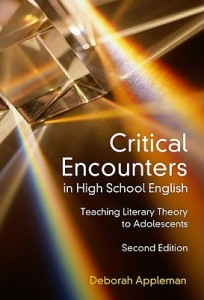Commentary on Deborah Appleman’s Critical Encounters in High School English: Teaching Literary Theory to Adolescents
This professional development text made me reconsider my teaching philosophy. I’ve used lenses before. In my college credit course (for high school students), I asked students to use nonfiction and fiction as lenses to view other texts. It felt academic, and I believe my students benefited from this skill, but Appleman takes theory a step beyond what I was doing. As a graduate of English Education, critical theory was familiar to me, but I always felt as if I had to teach theory in a hidden way. We talked about gender, but I never told students they were using critical theory.
For most teachers, critical theory is important for advanced placement, high school English classrooms. Appleman provides scaffolding and proves that theory can be used in grades 6-12 and for all levels. Her materials are accessible and engaging.
According to Appleman, teachers should use literary theory as critical lenses to help students understand the ideologies inherent in texts (p. 3) and use skills of reading and writing to come learn about the world (p. 2). When students read, there are multiple contexts at play, and she provides theoretical grounding and examples of various lenses for teachers: reader response, privilege and social class, gender, post colonialism, and deconstruction. Each lens has its own chapter in her book.
Students bring their own contexts to their reading of a text, so using critical theory allows them to view the literature through a different lens. Reading, interpretation and criticism are all important skills, and too often, teachers “relegate only the reading to students” (p. 6), and through Appleman’s suggestions, we give students authority and power.
No matter how uncomfortable it feels, students should learn to question the notion of a single truth and show the multiplicities that exist in reading. “Meanings are constructed; we create meanings that are influenced by who we are and what we are culturally; historically; psychologically; and, in the case of the Baker version of Miss Muffet, vocationally” (p. 20). Reading allows students to gain perspective of other lenses and theories, but also of their own lives, where the text acts as an equal partner with the reader (p. 31).
There are a plethora of activities and lessons for teachers in the appendix of the book. This book is extremely practical, and I felt as if I could immediately employ the ideas in the classroom, given the resources Appleman provides. I highly recommend this text to teachers.

1 thought on “Teaching Critical Theory to ALL Students”